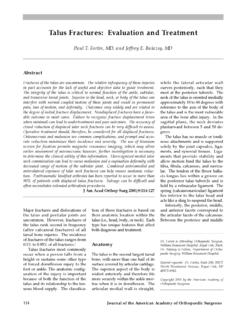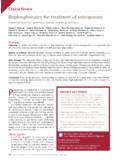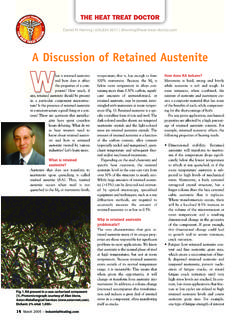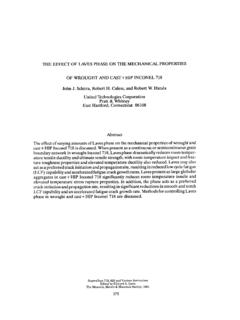Transcription of A STUDY OF TYPICAL PARACHUTE INJURIES OCCURRING IN …
1 This is an enhanced PDF from The Journal of Bone and Joint Surgery The PDF of the article you requested follows this cover page. A STUDY OF TYPICAL PARACHUTE INJURIES OCCURRING IN. TWO HUNDRED AND FIFTY THOUSAND JUMPS AT THE. PARACHUTE SCHOOL. C. Donald Lord and James W. Coutts J Bone Joint Surg Am. 1944;26:547-557. This information is current as of May 16, 2007. Reprints and Permissions Click here to order reprints or request permission to use material from this article, or locate the article citation on and click on the [Reprints and Permissions] link. Publisher Information The Journal of Bone and Joint Surgery 20 Pickering Street, Needham, MA 02492-3157. A STUDY OF TYPICAL PARACHUTE INJURIES OCCURRING IN TWO. HUNDRED AND FIFTY THOUSAND JUMPS AT THE PARACHUTE . SCHOOL. BY MAJOR C. DONALD LORD, Medical Corps Surgeon, The PARACHUTE School AND LIEUTENANT COLONEL JAMES W. COUTTS. A8sistant Commandant, The PARACHUTE School PARACHUTE jumps at Th@ PARACHUTE School have increased progressively from their inception in 1941 to the time of this writing.
2 PARACHUTE INJURIES at The PARACHUTE School have proportionately decreased progressively, until at the present time a jumper has roughly only a one per cent. chance of being injured in any way in any one PARACHUTE descent. This remarkable increase in PARACHUTE activities, in spite of the decrease in the rate of injury, establishes a wealth of clinical material for STUDY . This clinical material has been used in preparing this report. Certain types of training INJURIES and fractures from jumping have occurred re peatedly, until there now exist several clinical entities recognized as TYPICAL PARACHUTE INJURIES . These will be discussed subsequently. In this report, the writers have analyzed the material at hand according to: 1. The type of injury most common to each of the four training stages, and the anatomy, physiology, and, where possible, the mechanics involved in producing the injury. 2. The immediate and follow-up care of the injured provided at The PARACHUTE School. 3.
3 New training techniques and apparatus accounting for the diminishing rate of injury. 4. New methods of selection employed in choosing PARACHUTE personnel. An injury has been arbitrarily defined as a condition directly resulting from train ing, which causes the student to lose one day or more from duty. Minor sprains, lac erations, contusions, or exhaustive states in students who can be rehabilitated at The PARACHUTE Medical Unit and returned to duty within a few hours are not considered statistically as . INJURIES . The PARACHUTE course of training consists of four stages briefly described for the purpose of orientation as follows: 1. A Stage: calistHenics, rope-climbing, running, and jumping from low four-foot to six-foot platforms into sawdust pits. 2. B Stage: tumbling, trainasium, landing trainer, jumps from mock doors (four to six feet), jumps from mock towers (thirty to thirty-five feet), and suspended-harness drill. 3. C Stage: daily jumping from the 250-foot towers (free and controlled), and land ing by PARACHUTE on sawdust.
4 Tumbling is reviewed, and PARACHUTE control is practised. 4. D Stage: The applicant makes the'necessary number of plane jumps to qualify as a parachutist ; the jumps are made from a plane in flight, and the landing is made on level and uneven terrain. The physical hardening accomplished through A-Stage training puts most applicants at something near physical perfection. It has been found that in men physically at their best, fear phenomena in the apparatus of the next three stages are less prone to develop. The strain or tear of the right rectus muscle has proved to be the most frequent cause of disability in A-Stage training, and the most interesting clinically, since it closely simu lates acute appendicitis. This occurs in rope-climbing, presumably when the lower ex tremities are raised at right angles to the body, and the legs grasp the rope, as shown in Figure 1. It is believed that in the attempt to reach the top of the rope, an unusually strong VOL. XXVI. NO. 3, JULY 1944 547.
5 548 C. D. LORD AND J. W. COUTTS. effort is made, in some cases causing a definite sharp pain in the abdomen and resulting in the following clinical syndrome: The patient appears at The PARACHUTE Medical Unit, complaining of pain in the abdomen, and walking with the hips slightly flexed. The simple process of getting on the examining table is difficult because of the pain. With the patient standing, the abdomen appears relaxed, there being no effort to hold in the abdomen . In those cases with hematoma formation, a definite bulge can he seen along the course of the rectus muscle. Inspection further reveals some subcutaneous ecchymo sis (after four to seven days have elapsed), extending downward from the point of maximum tenderness. The muscle is exquisitely tender on light palpation, and the patient i-esists any sort of deep ljressule. When asked to raise the body from the prone position, keep ing the lower extremities flat on the table, severe pain is experienced. These cases occur in the right rectus in 90 per cent.
6 , and in the. left in 10 per It is believed that. this is due to the greater effort. which is exerted on the right side in the majority of cases. A. white blood count of 9,000 to 11,000 OCCUI'Stile day following the injury, with polymor phonucleal' leukocytes ranging from 70 to 80 per cent. Now that the cause has been determined, the diagnosis can readily he made, but mans- patients have been hospitalized for observation for appendicitis. One patient. was operated upon. A hematoma helo@v the rectus was found. The wound was closed and the appendix was not removed. Since act. of tumbling has proved effective in disseminating the shock of landing, the proper technique of tumbling is drilled the applicants over and over again daily, until a smooth, propei-lv executed tumble automatically follows contact. with the ground from any This enlphasis on tumbling leads to the TYPICAL injury of Stage B,- - the acromioclavicular contusion and the aci'omioclavicular sepai' Figures 2 and 3.
7 @ @( . N,..,..t @ s. /. It ri ). - . - .., @ FIG. 1. Illustrating the mechanism of the right rictus strain or teal'. l'HlJOURNAL OF' BONE ANI) JOINT .St'RGERY. TYPICAL PARA('HUTE INJURIES 549. @ i'4@@@: I. @! /. /4 / .@ ., , 7. I. I. Pootograph by theLnited States Army Signal Corps Fin. 2. Tunihling front the landing trainer . If the tumbling is improperly executetl, the point of the shiotlidel' strikes thl( gI'OtlItd with greatest force, t'('stllt ing it) aci'onuoclavicular iiij ury. sIlO)\V t\V() training situations, in@'olving tulnbies which @uie l)eing l)l'ol)ei'lY exe('llted. The shoulder ti1) sl@)lll(l not touch the gi'ound; the forearm, held rigiollv by the tn ( (J)5,ao'ts as a bar o@@'ei'@vhich the bo@ \Vhen the triceps is relaxed, the shoulder ( omesin (lirect contact with the ground, anol the acronno)claviclllar injury occurs. Sepa nation of the acromioclavio'ular joint inthese INJURIES involves only the tearing of the artictilar capsule in some cases; the coracoclavicular ligaments remain intact and prevent the scapula and acromion from l)eing olisplaced In the more severe cases, the capsule and the coracoclavicular ligaments are torn, l Photograph by the United States Army Signal Corpt Fin.
8 3. Illustrating in greater detail the niechanism of acromioclavicular injury. VOL. XXVI, NO, 3. JULY 1944. 550 C. D. LORD AND J. W. COUTTS. and the acl'omion, being completely separated from the clavicle, is displaced downward by the weight of the upper extremity. In Figure 4, the acnomioclavicular separation is niarked, hut@the scapula and the acromion are depressed only slightly. In one case it. was felt. that the coracoclavicular ligaments had been stretched, but that the connection to tile clavicle had been maintained. This case was treated by placing a block in the axilla and strapping it to tile body; an additional sti'ap extended up over the latei'al end of the clavicle and the shouldel', and down postei'iorly, and was attached to tile block behind the axilla. The elbow was raised by means of a sling. Tilis patient retul'ne(l to full jum@) duty after five months, has no@@'qualified as a parachutist, and has 110 symptoms refer able to the shoulder. The less severe injury.
9 - namely, tile simple acl'olmo claviculan separat ion with slight, if any, tearing of the cmt@)sI1le l'esponds to in'in@o . hilization of the upper arn@and sill)IIldeI' for from t\\'() to fotit'. weeks. These students ale reads' fot' full pal'achute tluty ill this length of time, with 110 other tl'eatfllellt than phvs FIG. 4. iothel'apv 1111(1rest. I@oentg('nograIn illustrating TYPICAL acl'omioclavi('ular separation. In C and D Stages, tile iIljlll'ies have a common cause, namely, landing by PARACHUTE . rFhe INJURIES , \Vilile more frequent in D Stage, involve the same mechanism, and both will be desci'ibed to gether. Tilel'e are tivo TYPICAL PARACHUTE leg INJURIES . 5l@hefirst, resulting from a para chute jun'ij@,is the double fracture, involving the lower third of the fibula and the Posterior lip of the tibia. The mechanisms of this fracture is explaine(I on tile 1)as1@sof a (loui)le force. It is thought that when this fracture occurs, tile foot@is i' externally an(l is forced posteriorly on contact with the ground.))
10 When the foot is rotated externally, the anterior portion of the body of the talus (astragalus) P1'esses against the anterior border of the inner surface of the external malleolus, forcing it outward a-mid backward. If the force is sufficient, and if the inferior tibiofibular ligament. remains intact, this force tends to cause an obli(lue fracture of the lower end of the fibula, usually about two inches above the tip. The posterior force is the result of the forward motion of the foot as it strikes the ground. The impact is transmitted up the metatarsals, through the tarsus, and forces off the posterior tihial lip. In the presence of a ground wind, and with oscillation at the time of landing, a more violent eversion of the ankle may occur, resulting in the trimalleolan fracture described by Lewin in his STUDY of the foot and ankle. In these cases, fracture of the internal and external malleoli and the posterior tihial lip occurs. This tnimalleolar fracture, however, is considerably less frequent than that involving the fihula and posterior tihial lip alone.)








